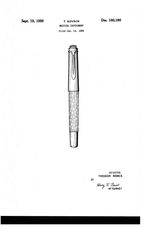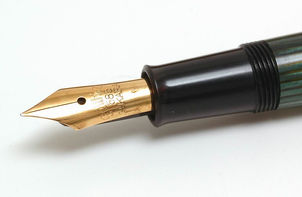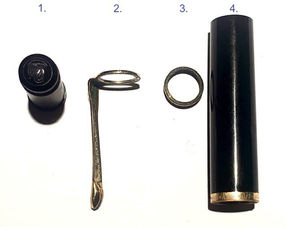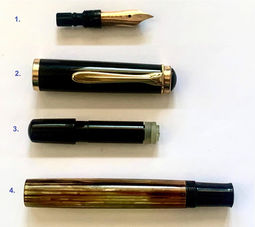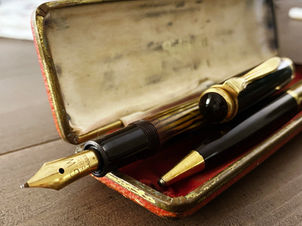top of page
Pelikan 400 (ca.1950) - the first year version
On May 25, 1950, model 400 was introduced as the new flagship model (Pelikan Schreibgeräte). Although model 400 series were introduced after WWII (The Fall of Fountain Pens), the glass negatives in the Pelikan archive indicate that design study for model 400 had been started in late 1930's (Pelikan Schreibgeräte). Technologically and physically, model 400 was the successor of model 100N. Like 100N, model 400 had the differential piston filling mechanism and many parts were interchangeable with model 100N (e.g. nib, piston seal, piston rod, spindle). Model 400 and 100N coexisted for 4 years (1950-1954). On the other hand, there were many changes/upgrades in model 400.
-
Dimension: The diameter was almost same as that of model 1ooN⁽¹⁾, but about 5 mm longer than model 100N with caps closed. But, with caps posted, model 1ooN is much longer than model 400 (Pelikan catalog No.70B (1951)).
-
Nib unit: Model 400 had the redesigned feed and socket. The new ebonite feed (the first type feed) was longer than that of model of 100N, and had four lamellas and more complicated ink and air channels than old 100N feed. The new ebonite socket became much shorter than that of model 100N, and adopted a friction fit nib unit in the beginning. There were no threads on the socket nor inside the section. The first type feed had a slit at its backside. This made it springy to keep the nib unit in place (Fountain Pen Network). But shortly after (in August 1950) model 400 went back to a traditional screw-in fit nib unit (Pelikan Schreibgeräte). So, produced only for a few months, the first year model is most characterized by its friction fit nib unit⁽²⁾. The imprint and dimension of the nib was identical to that of model 100N. The model 100N was available with gold nibs and CN nibs, while model 400 had only gold nibs from the start.
-
Cap: The clip resembled more closely the face and beak of a pelican than that of model 100N did. The clips had the markings on the back of the clips⁽³⁾. The stepped and threaded cap top was friction fit from the inside of the cap tube, and the clip was secured to the cap top by the "crown" (metal nut). The cap tube had a wide brass ring without any imprint. The cap ring, which extends into the the back of cap tube, not only served a decorative role but also protected the cap tube from cracks by reinforcing it from inside (Pelikan Schreibgeräte). The crown, clip, and cap ring were gold filled (Pelikan catalog No.70B (1951)).
-
Body: The barrel didn't have a sleeve and definite ink window like model 100/100N. The barrel construction was two-layered: the striped outer layer was solvent-welded alternating colored and transparent cellulose acetate strips, and the inner layer was injection molded acrylics. Ink was visible through the transparent stripes (Pelikan Schreibgeräte). Ink capacity was increased to 2.0 ml (Pelikan-collectibles). The barrel had an imprint "Günter Wagner Pelikan" near the turning knob⁽⁴⁾. The acrylic section was permanently ultrasound-welded to the inner barrel layer. Model 400 had the newly developed disk-shaped transparent nylon seal (please refer to Pelikan 400 (ca.1952) for more information). The previously existing black elastomer seal was also used for model 400 seal (@stoen). The acrylic filling mechanism was fixed with the barrel in a friction fit manner. The piston seal was newly developed white discoid plastic seal (Pelikan 100N (ca.1950)). The nib specification was engraved on the turning knob.
-
Color: The model was made in several colors, the main ones of which were green stripe, black stripe and gray stripe barrel with black cap, turning knob and section and tortoiseshell stripe barrel with brown cap, turning knob, and section. Of these colors, by far the most common is the green and black, echoing the traditional color scheme that distinguished Pelikan fountain pens at least as much as its logo (FountainPen.it).
Model 400, with its new clip in the shape of a pelican's beak and the vertical stripes of the body became one of the symbols of the post-war modernist style, achieving enormous success (FountainPen.it). In model 400, the modular engineering for easy maintenance and serviceability was combined with the elegant integrated appearance (@stoen).
On March 1, two months ahead of the model 400's introduction, model 450 mechanical pencil was introduced.
Sometime between May and September, 1950, model 500 with gold filled cap tube, crown, clip, and turning knob was introduced (Pelikan Schreibgeräte).
Note;⁽¹⁾Model 400 looks slimmer than model 100N to me, presumably due to long striped body.
⁽²⁾Pelikan adopted the same system again in 1980's when the company introduced model M400 (and M200) (Fountain Pen Network).
⁽³⁾These markings was introduced for the first time on model 400 (as far as I inspected, they are not found on model 100N or earlier models). They appear to be the manufactures' marks, as seen on earlier model 100 feeds. They are also found on the subsequent 400N and 400NN.
⁽⁴⁾Other variation such as "<Nib Size> GÜNTHER WAGNER PELIKAN", "GÜNTHER WAGNER GERMANY PELIKAN 400" are known. For further information, please see Fountain Pen Network.
Pelikan 400 (ca.1950)
By courtesy of @stoen.
Pelikan 400 (ca.1950)
By courtesy of Christof Zollinger. According to Christof, the pen still holds the nib unit well.
The explosion view of Pelikan 400 (ca.1951)
By courtesy of @stoen.
The manufactures' marks? of the clips
Pelikan 400 with an uncommon 18 ct. nib and a smooth cap top (ca.1950)
This pen seemed to be the export model for the French market.
Pelikan 450
Matching pencil of model 400.
Friction fit nib unit of M400 and M200
bottom of page
